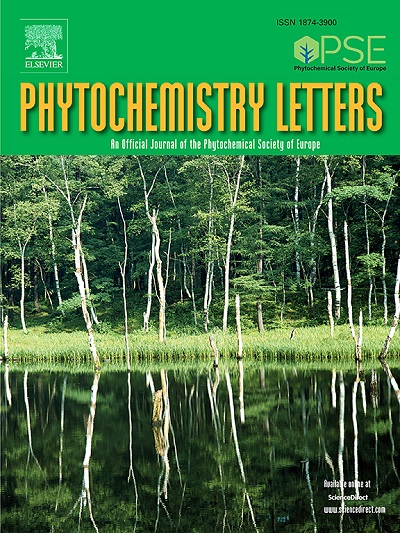从泰国栽培的刺毛藤叶中分离出两个新的巨藤甲苷
IF 1.4
4区 生物学
Q4 CHEMISTRY, MEDICINAL
引用次数: 0
摘要
两个新的megastigmane苷,chayaionosides A(1)和(2),连同breyniaionoside E (3), euodionoside F(4),(6年代,9 s) -roseoside(5)、苄O -β-D-apiofuranosyl -(1→6)β-D-glucopyranoside(6)、苄O -α-L-rhamnopyranosyl -(1→6)β-D-glucopyranoside (7), canthoside (8), syringin (9), coniferin (10), scopolin (11), (+) -lariciresinol-4-O -β-D-glucopyranoside (12), dehydrodiconiferyl四点-β-D-glucopyranoside(13)、山柰酚3点-α-L-rhamnopyranosyl -(1→2)β-D-galactopyranoside (14),山奈酚3-O-新橙皮苷(15)、山奈酚3-O-α- l-鼠李糖基-(1→6)-β- d -半乳糖苷(16)、山奈酚3-O-芦丁苷(17)、山奈酚3-O-(2″、6″-二- o -α- l-鼠李糖基)-β- d -半乳糖苷(19)、山奈酚3-O-(2″、6″-二- o -α- l-鼠李糖基)-β- d -葡萄糖苷(20)从泰国种植的乌头木犀叶中分离得到。结构解释是基于物理数据和光谱证据,包括一维和二维核磁共振分析。本文章由计算机程序翻译,如有差异,请以英文原文为准。
Two new megastigmane glycosides from the leaves of Cnidoscolus aconitifolius cultivated in Thailand
Two new megastigmane glycosides, chayaionosides A (1) and B (2), together with breyniaionoside E (3), euodionoside F (4), (6S,9S)-roseoside (5), benzyl O-β-D-apiofuranosyl-(1→6)-β-D-glucopyranoside (6), benzyl O-α-L-rhamnopyranosyl-(1→6)-β-D-glucopyranoside (7), canthoside A (8), syringin (9), coniferin (10), scopolin (11), (+)-lariciresinol-4-O-β-D-glucopyranoside (12), dehydrodiconiferyl 4-O-β-D-glucopyranoside (13), kaempferol 3-O-α-L-rhamnopyranosyl-(1→2)-β-D-galactopyranoside (14), kaempferol 3-O-neohesperidoside (15), kaempferol 3-O-α-L-rhamnopyranosyl-(1→6)-β-D-galactopyranoside (16), kaempferol 3-O-rutinoside (17), drabanemoroside (18), kaempferol 3-O-(2″,6″-di-O-α-L-rhamnopyranosyl)-β-D-galactopyranoside (19), and kaempferol 3-O-(2″,6″-di-O-α-L-rhamnopyranosyl)-β-D-glucoside (20) were isolated from the leaves of Cnidoscolus aconitifolius cultivated in Thailand. The structural elucidations were based on physical data and spectroscopic evidence, including 1D and 2D NMR analyses.
求助全文
通过发布文献求助,成功后即可免费获取论文全文。
去求助
来源期刊

Phytochemistry Letters
生物-生化与分子生物学
CiteScore
3.00
自引率
11.80%
发文量
190
审稿时长
34 days
期刊介绍:
Phytochemistry Letters invites rapid communications on all aspects of natural product research including:
• Structural elucidation of natural products
• Analytical evaluation of herbal medicines
• Clinical efficacy, safety and pharmacovigilance of herbal medicines
• Natural product biosynthesis
• Natural product synthesis and chemical modification
• Natural product metabolism
• Chemical ecology
• Biotechnology
• Bioassay-guided isolation
• Pharmacognosy
• Pharmacology of natural products
• Metabolomics
• Ethnobotany and traditional usage
• Genetics of natural products
Manuscripts that detail the isolation of just one new compound are not substantial enough to be sent out of review and are out of scope. Furthermore, where pharmacology has been performed on one new compound to increase the amount of novel data, the pharmacology must be substantial and/or related to the medicinal use of the producing organism.
 求助内容:
求助内容: 应助结果提醒方式:
应助结果提醒方式:


